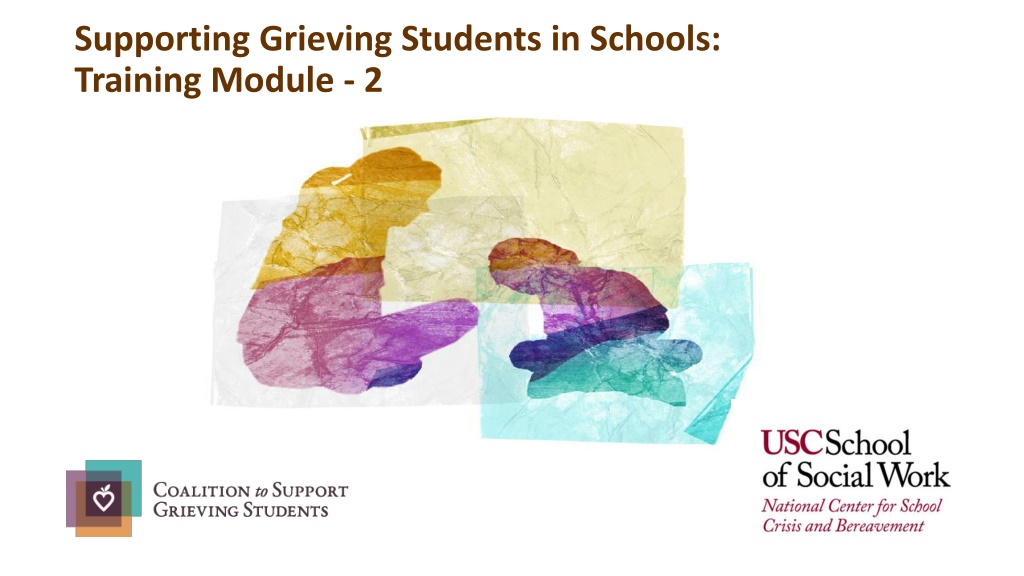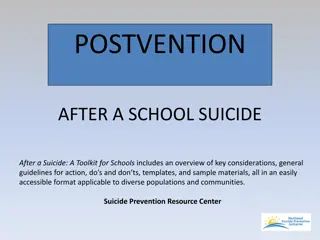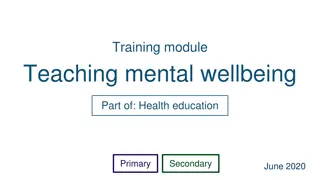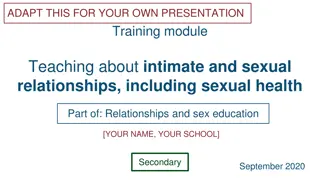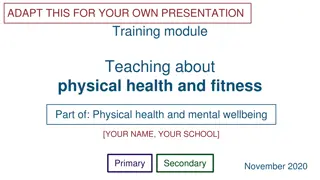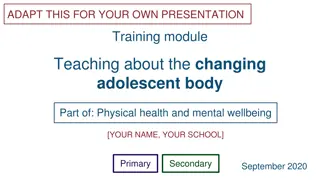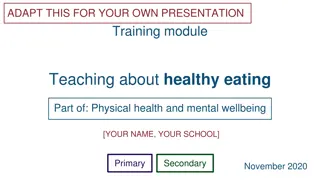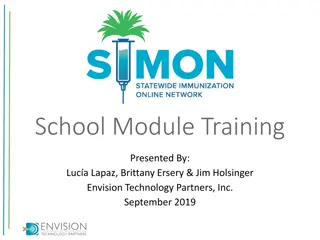Supporting Grieving Students in Schools - Training Module
This training module equips school staff with essential knowledge and skills to support grieving students effectively. It covers topics such as understanding barriers faced by children and staff, initiating conversations, providing cultural sensitivity, and offering ongoing support through various stages of grief and transitions.
Download Presentation

Please find below an Image/Link to download the presentation.
The content on the website is provided AS IS for your information and personal use only. It may not be sold, licensed, or shared on other websites without obtaining consent from the author. Download presentation by click this link. If you encounter any issues during the download, it is possible that the publisher has removed the file from their server.
E N D
Presentation Transcript
Supporting Grieving Students in Schools: Training Module - 2
Supporting the Grieving Student This module will help school staff understand how to support the grieving student through presentations about 1. Barriers children and school staff face 2. How to initiate a conversation and what to say 3. How to act with a grieving child 4. Goals of support with a grieving child 5. Checking a child s understanding of death 6. Cultural sensitivity 7. Supporting children with guilt and shame 8. Offering academic support proactively 9. Preparing students to manage grief triggers 10. Providing support over time 11. Supporting transition between grades and schools
Barriers for Children in Talking About Loss Children may Conclude they have done something wrong by talking about death and avoid raising the subject again Hold in their feelings as a way to support their family Try to look fine and reassure family they are okay when they really need support Not fully understand death and loss Have problems expressing their complicated feelings Feel overwhelmed by the experience and their strong feelings
Initiating the Conversation Limit personal sharing Express concern Offer practical advice Be genuine Offer reassurance Invite the conversation Maintain contact Listen and observe
What not to say Don t Say This Say this instead I know just what you re going through. Can you tell me more about what this has been like for you? Most people have strong feelings when something like this happens to them. What has this been like for you? You must be incredibly angry. This is hard. But it s important to remember the good things in life, too. What kinds of memories do you have about the person who died? At least he s no longer in pain. What sorts of things have you been thinking about since your loved one died?
Dont Say this Say this instead I lost both my parents when I was your age. Tell me more about what this has been like for you. You ll need to be strong now for your family. It s important to get a grip on your feelings. How is your family doing? What kinds of concerns do you have about them? My dog died last week. I know how you must be feeling. I know how I ve felt when someone I loved died, but I don t really know how you re feeling. Can you tell me something about what this has been like for you?
How to Act Be present and authentic Listen more, talk less Avoid trying to cheer up students or their families Accept expressions of emotion Show empathy Don t be afraid to show emotions Step in to stop harmful behaviors when safety is a concern
Goals of Support Decrease the sense of isolation Increase academic function Increase the likelihood children will talk with their families Increase the likelihood children will talk with and receive support from their peers Identify problems in the family Connect with students on something of immense importance
Checking a Childs Understanding of Death Start by asking children what they understand about death Give them simple, direct and developmentally-appropriate explanations Ask them to explain back to you what they understand Correct any misunderstandings or misconceptions.
Cultural Sensitivity Remember that the fundamental experience of grief is universal Ask questions Ask openly when you are unsure what would be most helpful for a family or individual Watch out for assumptions Be empathetic, thoughtful and sensitive
Supporting Children with Guilt and Shame Discuss guilt and shame explicitly with grieving children Ask about the kinds of thoughts, questions, or feelings they have been having Describe the kinds of reactions related to guilt and shame that people often have Normalize the experience of guilt and shame while creating a safe environment Talk to a school mental health professional if these emotions are persistent or causing marked distress
Offer Academic Support Proactively Change an assignment Change the focus or timing of a lesson Reschedule or adapt tests
Preparing Students to Manage Grief Triggers Identify a safe space or location where the student can go Provide the child with the name of an adult he or she can see when feeling upset or wishing to talk Set up procedures that allow the student to obtain support Allow the child to call a parent or family member Give permission and encouragement for the child to speak with other school staff Offer private time to talk over feelings, questions, or other concerns
Anticipate & Minimize Triggers Expect that triggers may occur around holidays, Mother s Day and Father s Day, the child s birthday, the birthday of the deceased, or the anniversary of the person s death Introduce class activities in a way that acknowledges absences and offers alternatives Make an effort to reach out to grieving students at school events where the absence of a loved one may be especially noticeable Introduce subjects such as serious illness, accidental death, war, or violence with sensitivity
Providing Support Over Time Lifetime? One year? One month? One week? One day?
Supporting Transitions With the student s knowledge and the family s permission, school professionals can communicate the student s needs and describe strategies that have been effective in providing support High School Team The team can explore ways to provide some constancy in the support the student receives The school team can also help the family identify ways to prepare the new school to best support their child Middle School
This presentation was developed by This presentation was developed by David Schonfeld, M.D., University of Southern California Thomas Demaria, Ph.D., Long Island University C.W. Post Campus Marcia Quackenbush, M.S., M.F.T., M.C.H.E.S. With the support of members of the National Center for School Crisis & Bereavement Coalition to Support Grieving Students
For further information Toll Free: 877-53-NCSCB (877-536-2722) www.schoolcrisiscenter.org
www.grievingstudents.org * Six topic sections contain 2 - 4 video modules with each video accompanied by downloadable handouts that summarize the major points covered. * Links to additional resources for schools and families
www.achildingrief.com Schonfeld, D., and M. Quackenbush. After a Loved One Dies How Children Grieve and How Parents and Other Adults Can Support Them. New York, NY: New York Life Foundation, 2009.
Art Credits William T. Demaria willtad24@live.com Module 2 slide 8, 22 Daniel Pollera www.danielpollera.com Module 2 slides 9, 17
